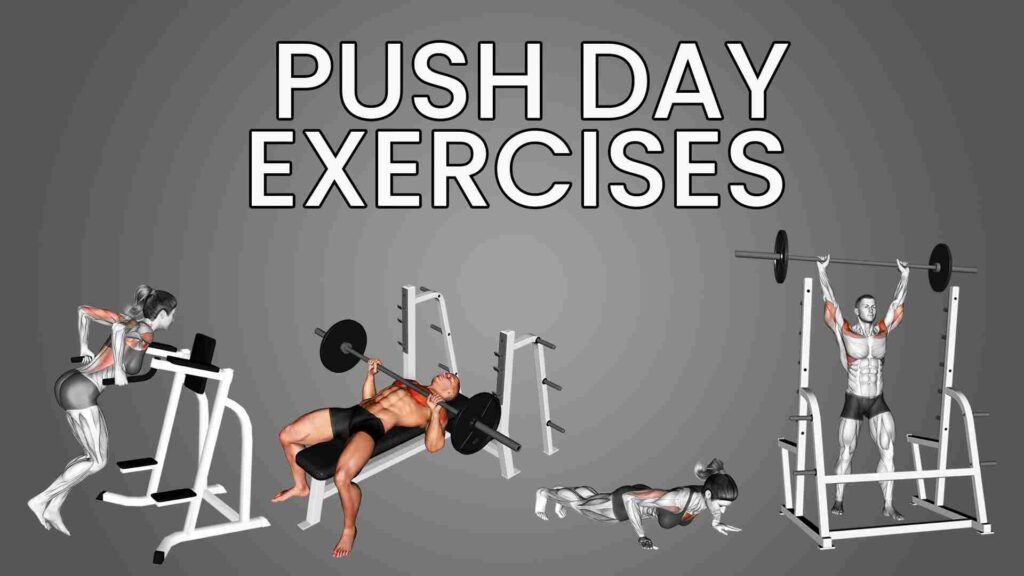Introduction
Welcome to the world of TRX training! If you’re looking to sculpt your physique and enhance your strength, you’ve come to the right place. In this blog, we’ll delve into the realm of TRX upper body workouts, a revolutionary approach to fitness that leverages your own body weight and gravity to challenge every muscle. Whether you’re a seasoned athlete or a fitness newbie, TRX workouts can be tailored to your level, making them a versatile addition to any fitness regimen. So, strap in and prepare to elevate your upper body strength to new heights! Let’s get started.
Understanding TRX Training
TRX training, short for Total Resistance Exercise, is a revolutionary approach to fitness that utilizes suspension training to engage multiple muscle groups simultaneously. Developed by a former Navy SEAL, Randy Hetrick, TRX has gained immense popularity for its versatility and effectiveness in providing a full-body workout. Here, we will delve into the fundamental aspects of TRX training, shedding light on what makes it a game-changer in the fitness world.
What is TRX?
TRX is a suspension training system that uses adjustable straps anchored to a stable point, allowing users to leverage their body weight against gravity. The straps, often referred to as “suspension trainers,” provide an unstable yet controlled environment, challenging the body to maintain balance and stability during exercises.
How Does TRX Work?
The beauty of TRX lies in its simplicity and adaptability. The user’s body weight becomes the resistance, and the angle of the body in relation to the ground determines the intensity of the exercise. By adjusting the length of the straps or changing body positioning, users can easily modify the difficulty of each exercise, making TRX suitable for individuals of all fitness levels.
Why Choose TRX for Upper Body Workouts?
- Versatility: TRX offers a wide range of exercises that target the upper body, allowing for a comprehensive workout.
- Engagement of Stabilizing Muscles: The instability created by the suspension system forces the activation of stabilizing muscles, contributing to improved overall strength and balance.
- Scalability: Whether you’re a beginner or an advanced fitness enthusiast, TRX workouts can be adapted to meet your current fitness level, making it an inclusive option for everyone.
- Low Impact: TRX exercises are generally low impact, reducing the risk of joint strain and making it suitable for individuals with various fitness backgrounds.
Getting Started with TRX
- Adjusting the Straps: Ensure that the TRX straps are at the appropriate length for the exercise you’re performing. Longer straps generally increase the difficulty.
- Body Positioning: Pay attention to your body position, as small adjustments can significantly impact the muscles targeted during an exercise.
- Safety First: While TRX is highly adaptable, it’s crucial to maintain proper form to prevent injuries. Begin with simpler exercises and gradually progress as your strength improves.
Understanding the basics of TRX training sets the foundation for an effective upper-body workout. Whether you’re new to TRX or looking to enhance your current workout regimen, the versatility and effectiveness of TRX training make it a valuable addition to any fitness journey.
Equipment Needed for TRX Training
To do TRX training, you will need some basic equipment, such as:
- TRX straps and mounting equipment: These are the main components of TRX training, and they allow you to perform various exercises using your own body weight and gravity. You can attach the straps to a sturdy anchor point, such as a door, a beam, a tree, or a wall. SHOP FOR THE TRX BAND ON AMAZON
- Kettlebell: This is a weighted ball with a handle that you can use to add resistance and challenge to your TRX exercises. You can swing, lift, or press the kettlebell to work different muscle groups and improve your power and endurance. SHOP FOR THE KETTLEBELL ON AMAZON
- Resistance bands: These are elastic bands that you can use to increase or decrease the difficulty of your TRX exercises. You can wrap the bands around the handles or the foot cradles of the TRX straps, and adjust the tension according to your fitness level and goals. SHOP FOR THE RESISTANCE BAND ON AMAZON
- Mat: This is a soft surface that you can use to protect your joints and provide comfort when you do TRX exercises that involve lying down or kneeling on the floor. SHOP FOR THE WORKOUT MAT ON AMAZON
These are the essential equipment that you will need for TRX training, but you can also add other accessories, such as gloves, towels, water bottles, etc., to enhance your workout experience. TRX training is a versatile and effective way to improve your strength, balance, and flexibility, and you can do it anywhere with minimal equipment.
Best TRX Upper Body Workouts
TRX exercises are a great way to build upper body strength using your own body weight and gravity. Here are some of the best TRX exercises for your upper body;
1. TRX Chest press
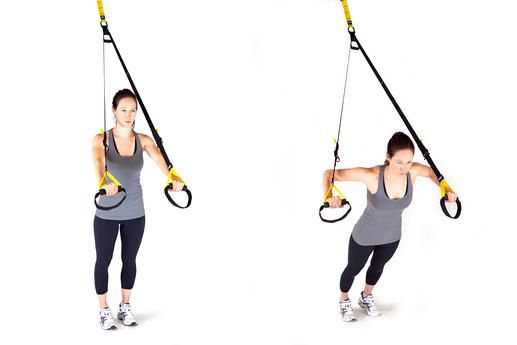
This exercise primarily targets the pectoralis major (chest muscles), but also works the anterior deltoids (front shoulders) and the triceps brachii (back of the upper arm). Perform 3-4 sets of 15 reps with 30 seconds of rest.
Adjust the TRX band grips at chest level. Hold the grips firmly. Keep your toes steady on the floor, and bend forward till you’ve formed an acute angle with the floor. At this point, your palms should be beside your chest. Engage your chest, and push yourself backward till the arms are completely extended. Hold the position for a second before lowering yourself to the starting position.
2. TRX Chest fly

This exercise primarily targets the pectoralis major (chest muscles), with secondary emphasis on the anterior deltoids (front shoulders) and the biceps brachii (front of the upper arm). Perform 3-4 sets of 15 reps with 45 seconds of rest.
Stand with the TRX band adjusted at hip level or slightly above. Hold the grips firmly. Keep your feet firmly on the floor, and bend your body forward while the arms extend to the sides. Engage your chest to push yourself back to the starting position while the arms come back to the sides.
3. TRX Back row
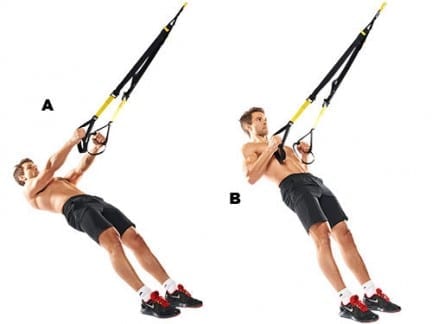
This exercise primarily targets the latissimus dorsi (large muscles of the back), but also works the rhomboids, trapezius, and biceps brachii. Perform 5 sets with reps decreasing from 20 to 10 in each set and 30 seconds of rest.
Adjust the band to chest level. Hold the bands so that your palms face outwards. Lower your body towards the floor, but ensure that the back is towards the floor. At the starting position, the arms should be completely extended and the body slanted. Engage the lats, and pull yourself upwards. Hold the position for a second before steadily lowering yourself to the starting position.
4. TRX Face pull
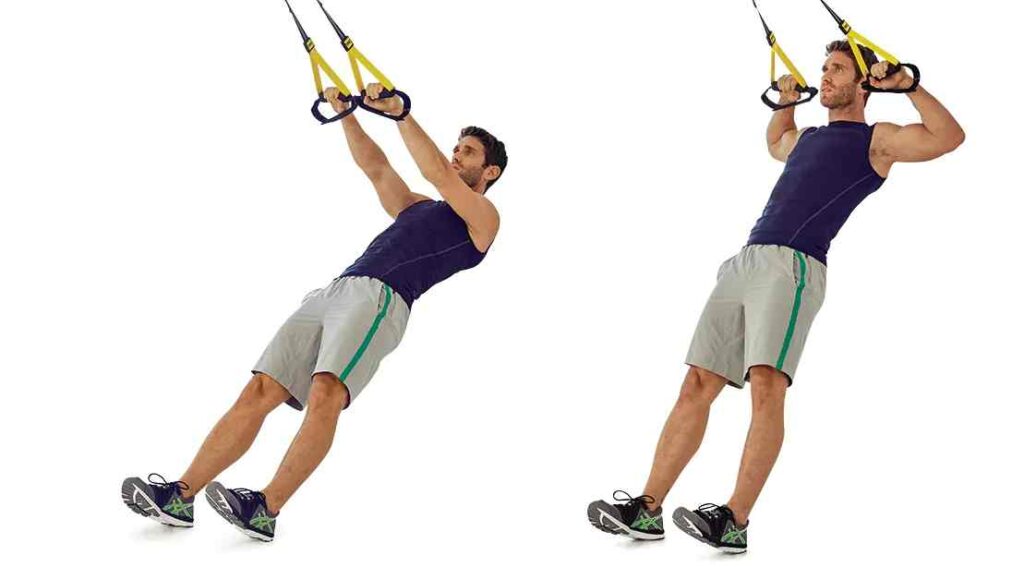
This exercise primarily targets the posterior deltoids (rear shoulders), rhomboids, and trapezius (upper back muscles), but also works the biceps brachii. Perform 3 sets of 12-15 reps with a rest period of 60 seconds between each set.
Adjust the TRX bands at face level. Grip the bands, and lower your body towards the floor, with the back towards the floor. Your starting position is when the arms are fully extended. Engage your upper back muscles, and pull yourself into the starting position. Hold the position for a second before moving back to the starting position.
5. TRX Bicep curl
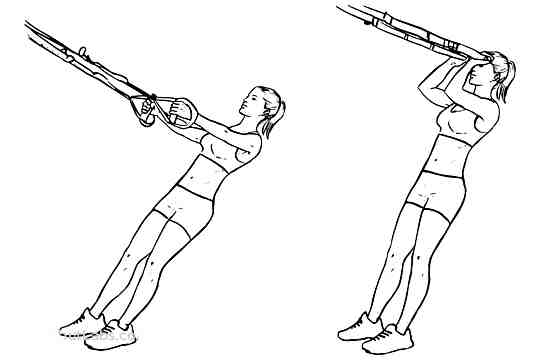
As the name suggests, this exercise primarily targets the biceps brachii. It also engages the brachialis (a muscle that lies underneath the biceps brachii) and the brachioradialis (a muscle of the forearm). Perform 3-5 sets of 8-15 reps with 60 to 90 seconds of rest.
Adjust the TRX band at shoulder level. Hold the grips, and turn your palms towards yourself. Move your body towards the floor with your back facing the floor. Your starting position will have both hands completely extended. Keep your elbows stable, and engage your biceps to pull yourself back up. Squeeze the biceps for a second before slowly moving back to the starting position.
6. TRX Push-up
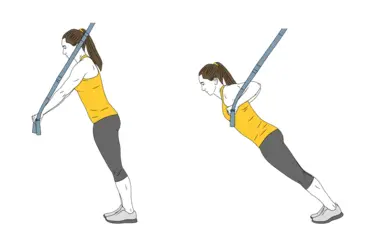
This exercise primarily targets the pectoralis major (chest muscles), anterior deltoids (front shoulders), and triceps brachii. Perform 3-5 sets of 8-15 reps with 60 to 90 seconds of rest.
Hook your toes through the TRX stirrups so the tops of your feet face the floor. Lift your body up so your weight rests on the palms of your hands. Keeping core tight, bend elbows to the lower chest between hands. You’ll feel your chest and shoulders working as you press back up to the starting position.
7. TRX Inverted Row
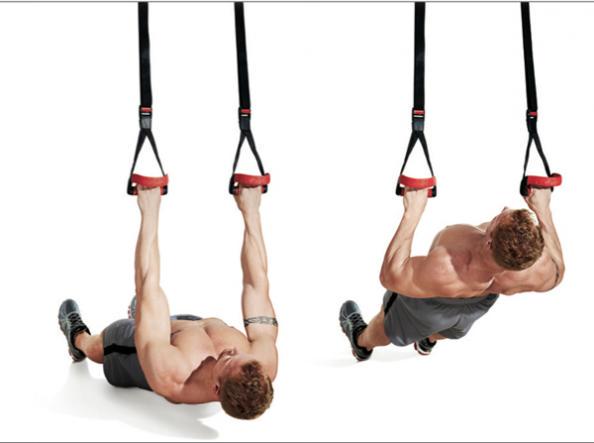
This exercise primarily targets the latissimus dorsi (large muscles of the back), rhomboids, trapezius, and biceps brachii. Perform 3-5 sets of 8-15 reps with 90 to 120 seconds of rest.
Lie directly underneath the TRX. Bend knees and plant feet on the floor. Reach up to grasp the handles, palms facing each other, arms fully extended, as you lift your body a few inches off the floor. Keeping elbows close to your sides, bend your elbows to pull your torso up toward the handles until your body forms a straight line from shoulders to knees. Lower to return to the starting position. You’ll put your biceps and back to work as you raise and lower your torso, slowly and with control.
Incorporating these essential TRX upper body exercises into your routine offers a holistic approach to strength training. Remember to focus on proper form and controlled movements to maximize effectiveness and minimize the risk of injury.
Tips for an Effective TRX Upper Body Workout
Achieving the best results from your TRX upper body workout requires more than just going through the motions. Here are some key tips to ensure an effective and rewarding session:
- Warm-Up Thoroughly: Before diving into TRX exercises, spend 5-10 minutes warming up your muscles. This increases blood flow, flexibility, and prepares your upper body for the upcoming challenges.
- Adjust Strap Length: Proper strap length is crucial for targeting specific muscle groups and maintaining correct form. Ensure that the TRX straps are adjusted to an appropriate length to maximize the effectiveness of each exercise.
- Focus on Form Over Repetition: Maintain proper form throughout each exercise to target the intended muscles and prevent injury. Quality is more important than quantity when it comes to TRX workouts.
- Engage Your Core: The beauty of TRX lies in its ability to engage your core during every exercise. Keep your core tight and activated to enhance stability and balance, making each movement more effective.
- Progress Gradually: If you’re new to TRX, start with simpler exercises and gradually progress to more challenging ones. This ensures that your muscles adapt and strengthen over time, reducing the risk of overexertion.
- Mix Up Your Routine: Keep your workouts interesting and challenging by incorporating a variety of TRX upper body exercises. This not only targets different muscle groups but also prevents boredom and plateaus in your fitness journey.
- Allow for Recovery: Give your muscles time to recover between TRX upper body sessions. Overtraining can lead to fatigue and potential injury, so listen to your body and incorporate rest days into your routine.
- Combine TRX with Other Exercises: While TRX is excellent for targeting the upper body, combining it with other exercises, such as cardio or lower-body workouts, creates a well-rounded fitness routine for overall strength and conditioning.
ULTIMATE CHEST AND SHOULDER WORKOUT
By incorporating these tips into your TRX upper body workout routine, you’ll not only maximize the benefits but also enjoy a safer and more rewarding fitness experience.
Progression for TRX Workout
There are many ways to progress and vary your TRX upper body workout, depending on your goals, fitness level, and preferences. Here are some general tips and examples:
- To increase the difficulty of any TRX exercise, you can adjust your body position to create more resistance and instability. For example, you can move your feet closer to the anchor point, elevate your feet, or change the angle of your body relative to the floor.
- To decrease the difficulty of any TRX exercise, you can do the opposite: move your feet further away from the anchor point, lower your feet, or change the angle of your body to be more upright.
- You can also vary the tempo, range of motion, and number of repetitions and sets of any TRX exercise to challenge yourself in different ways. For example, you can perform the exercises faster or slower, with full or partial movements, or with more or fewer reps and sets.
- You can also mix and match different TRX exercises to target different muscles and create different combinations. For example, you can combine a TRX chest press with a TRX row, or a TRX bicep curl with a TRX tricep press, or a TRX push-up with a TRX fly.
- You can also add other equipment or exercises to your TRX upper body workout, such as dumbbells, kettlebells, bands, or bodyweight exercises. For example, you can perform a TRX chest press followed by a dumbbell chest fly, or a TRX row followed by a band pull-apart, or a TRX push-up followed by a burpee.
Remember to maintain proper form and control throughout each movement to maximize the effectiveness of the workout and prevent injury.
FAQs
Q 1. Can anyone do TRX upper body workouts?
Ans. Absolutely! TRX workouts are adaptable for all fitness levels. Beginners can start with basic exercises and gradually progress to more advanced moves. It’s important to listen to your body and make modifications as needed.
Q 2. How often should TRX upper body workouts be done?
Ans. The frequency of TRX workouts depends on individual fitness goals and overall exercise routine. For general fitness, 2-3 sessions per week is a good starting point. However, consistency is key, so find a schedule that works for you.
Q 3. Is TRX suitable for beginners?
Ans. Yes, TRX is beginner-friendly. The adjustable nature of the straps allows users to control the difficulty of each exercise. Beginners should focus on mastering proper form before progressing to more challenging movements.
Q 4. Are there any precautions to consider when doing TRX upper-body workouts?
Ans. While TRX is generally safe, it’s crucial to pay attention to form and technique to avoid injuries. Ensure that the TRX straps are securely anchored, and always warm up before starting your workout. If you have pre-existing health conditions or concerns, consult with a fitness professional or healthcare provider before beginning a TRX regimen.
Q 5. Can TRX be used for rehabilitation purposes?
Ans. Yes, TRX can be a valuable tool for rehabilitation. Its adaptable nature allows for low-impact exercises that can aid in recovery from certain injuries. However, it’s essential to consult with a healthcare professional or physical therapist to ensure that TRX exercises are appropriate for your specific condition.
Q 6. How long does a typical TRX upper body workout last?
Ans. The duration of a TRX workout varies based on individual preferences and fitness levels. A session can range from 30 minutes to an hour. It’s more important to focus on quality over quantity, ensuring each exercise is performed with proper form.
Q 7. Can TRX workouts replace traditional weight training for the upper body?
Ans. While TRX is an effective tool for building strength and muscle, it’s not necessarily a replacement for traditional weight training. Incorporating a mix of both TRX and traditional exercises can provide a well-rounded approach to upper body fitness, targeting muscles from different angles.
Conclusion
In conclusion, TRX upper body workouts offer a dynamic and effective approach to achieving a sculpted and strong physique. By understanding the fundamentals of TRX suspension training, properly setting up the equipment, and incorporating targeted exercises, you can experience a transformative impact on your upper body muscles.
The versatility of TRX workouts makes them suitable for individuals of all fitness levels, providing a challenging yet adaptable fitness solution.

Good day, and welcome to Fitthour. My name is Shubham Vijay, and I am a certified personal trainer and nutrition coach with 6 years of experience in the fitness industry. At Fitthour, we specialize in types of training, such as strength training, cardio, or HIIT, and our mission is to help clients achieve their fitness goals and improve their overall health.

